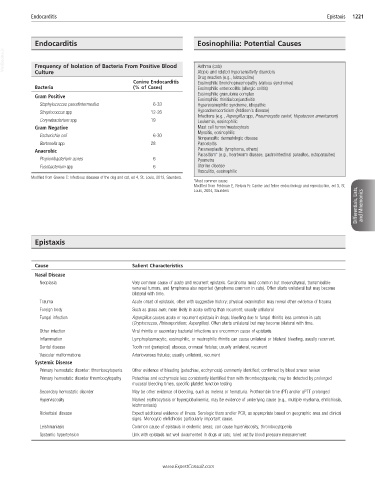Page 2463 - Cote clinical veterinary advisor dogs and cats 4th
P. 2463
Endocarditis Epistaxis 1221
Endocarditis Eosinophilia: Potential Causes
VetBooks.ir Frequency of Isolation of Bacteria From Positive Blood Asthma (cats)
Atopic and related hypersensitivity disorders
Culture
Drug reaction (e.g., tetracycline)
Canine Endocarditis Eosinophilic bronchopneumopathy (various syndromes)
Bacteria (% of Cases) Eosinophilic enterocolitis (allergic colitis)
Gram Positive Eosinophilic granuloma complex
Eosinophilic rhinitis/conjunctivitis
Staphylococcus pseudintermedius 6-33 Hypereosinophilic syndrome, idiopathic
Streptococcus spp 12-26 Hypoadrenocorticism (Addison’s disease)
Infections (e.g., Aspergillus spp, Pneumocystis carinii, Hepatozoon americanum)
Corynebacterium spp 19 Leukemia, eosinophilic
Gram Negative Mast cell tumor/mastocytosis
Escherichia coli 6-30 Myositis, eosinophilic
Nonparasitic dermatologic disease
Bartonella spp 28 Panosteitis
Anaerobic Paraneoplastic (lymphoma, others)
Parasitism* (e.g., heartworm disease, gastrointestinal parasites, ectoparasites)
Propionibacterium acnes 6 Pyometra
Fusobacterium spp 6 Uterine disease
Vasculitis, eosinophilic
Modified from Greene C: Infectious diseases of the dog and cat, ed 4, St. Louis, 2012, Saunders.
*Most common cause.
Modified from Feldman E, Nelson R: Canine and feline endocrinology and reproduction, ed 3, St.
Differentials, Lists, and Mnemonics
Louis, 2004, Saunders
Epistaxis
Cause Salient Characteristics
Nasal Disease
Neoplasia Very common cause of acute and recurrent epistaxis. Carcinoma most common but mesenchymal, transmissible
venereal tumors, and lymphoma also reported (lymphoma common in cats). Often starts unilateral but may become
bilateral with time.
Trauma Acute onset of epistaxis, often with suggestive history; physical examination may reveal other evidence of trauma
Foreign body Such as grass awn; more likely in acute setting than recurrent; usually unilateral
Fungal infection Aspergillus causes acute or recurrent epistaxis in dogs; bleeding due to fungal rhinitis less common in cats
(Cryptococcus, Rhinosporidium, Aspergillus). Often starts unilateral but may become bilateral with time.
Other infection Viral rhinitis or secondary bacterial infections are uncommon cause of epistaxis
Inflammation Lymphoplasmacytic, eosinophilic, or neutrophilic rhinitis can cause unilateral or bilateral bleeding, usually recurrent.
Dental disease Tooth root (periapical) abscess, oronasal fistulas; usually unilateral, recurrent
Vascular malformations Arteriovenous fistulas; usually unilateral, recurrent
Systemic Disease
Primary hemostatic disorder: thrombocytopenia Other evidence of bleeding (petechiae, ecchymosis) commonly identified; confirmed by blood smear review
Primary hemostatic disorder thrombocytopathy Petechiae and ecchymosis less consistently identified than with thrombocytopenia; may be detected by prolonged
mucosal bleeding times, specific platelet function testing
Secondary hemostatic disorder May be other evidence of bleeding, such as melena or hematuria. Prothrombin time (PT) and/or aPTT prolonged
Hyperviscosity Marked erythrocytosis or hyperglobulinemia; may be evidence of underlying cause (e.g., multiple myeloma, ehrlichiosis,
leishmaniasis)
Rickettsial disease Expect additional evidence of illness. Serologic titers and/or PCR, as appropriate based on geographic area and clinical
signs. Monocytic ehrlichiosis particularly important cause.
Leishmaniasis Common cause of epistaxis in endemic areas; can cause hyperviscosity, thrombocytopenia
Systemic hypertension Link with epistaxis not well documented in dogs or cats; ruled out by blood pressure measurement
www.ExpertConsult.com

